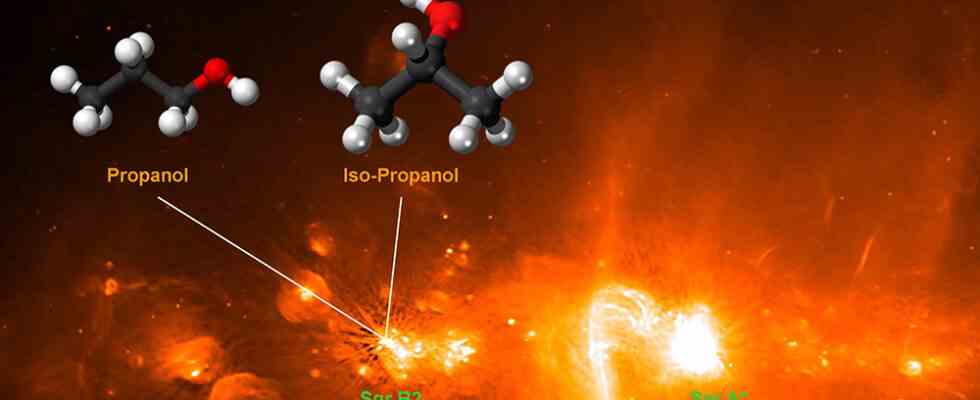Alcohol in space: Astronomers have detected the organic molecule isopropanol in space for the first time. This largest alcohol ever discovered in space is found in a cold gas cloud near the center of the Milky Way, where it exists in two structural variants, the team found using data from the ALMA radio observatory. These organic molecules are likely formed in the icy crust of interstellar dust grains.
Whether DNA building blocks, peptides, fullerenes or aromatic hydrocarbons: Complex organic molecules are not only found on Earth or other planets, but also plentifully in space. Especially in the cold gas clouds of stellar cradles or on interstellar dust grains, chemical reactions take place even in low light and cold temperatures, resulting in ever larger, more complex molecules. Also crucial building blocks of earthly life could once have come from outer space.
Isopropanol manhunt in space
Now astronomers have detected another organic molecule variant in space: isopropanol. This alcohol has one more carbon atom than ethanol and is mainly used as a solvent and cleaning agent. Isopropanol is also used for disinfection – during the corona pandemic, among other things. Arnaud Belloche from the Max Planck Institute for Radio Astronomy in Bonn and his colleagues used the Atacama Large Millimeter/submillimeter Array (ALMA) in Chile to investigate whether this alcohol also exists in space.
The radio telescopes of this observatory are particularly suitable for the detection of more complex molecules because of their high sensitivity, high angular resolution and wide frequency coverage. “The larger the molecule, the more spectral lines it will emit at different frequencies,” explains co-author Holger Müller from the University of Cologne. In addition, the spectra of different molecules overlap in cold, dense molecular clouds, which makes their identification even more difficult.
Largest alcohol ever detected in space
For their study, the astronomers aimed ALMA’s antennas at the molecular cloud Sagittarius B2 near the galactic center of the Milky Way. Organic molecules such as propylene oxide, propyl cyanide or ethanol have already been detected in this cradle. “Propanol has long been on our list of molecules to be tracked down,” explains Müller’s colleague Oliver Zingsheim. But only precise laboratory analyzes of the typical spectral characteristics of this molecule made the search possible.
With success: in the tangle of countless spectral lines, the researchers identified not only the signatures of methanol and ethanol but also seven lines that can be clearly assigned to isopropanol. “To our knowledge, this is the first interstellar detection of this molecule,” report Belloche and his colleagues. It is also the largest alcohol ever found in space.
According to the data, the density of isopropanol in the examined section of the gas cloud is around 130 trillion molecules per square centimeter – this is 30 times lower than that of interstellar ethanol.
Ice crust of interstellar dust grains as a “chemical factory”
In addition to isopropanol, the astronomers were also able to demonstrate the spectral signature of “normal” propanol. In this molecule, the -OH group is on the first instead of the second, middle carbon atom. “The detection of both isomers of propanol is of unique significance when it comes to determining the formation mechanism of the two isomers,” explains co-author Rob Garrod from the University of Virginia.
In the interstellar cloud, both propanol variants occur in a ratio of 60:40, as the researchers determined. With the help of a model, they were able to reconstruct the formation of the isopropanol on the basis of the observation data. Accordingly, the alcohol forms in the ice layer of interstellar dust grains. As the ice begins to sublime, precursor organic substances trapped in the ice come into contact with each other. This results in a reaction of OH radicals with propylene and propanols.
There’s a lot more out there
However, as the astronomers explain, only a fraction of the molecules and complex chemical reactions in the interstellar gas clouds have been deciphered. “There are still many unidentified lines in the ALMA spectrum of Sgr B2 and thus a lot of work to unravel the chemical composition of this important source,” explains senior author Karl Menten from the MPI for Radio Astronomy.
“In the near future, extending the ALMA instrumentation to lower frequencies will likely help us to further reduce the confusion in the spectrum and possibly identify more organic molecules in Sgr B2,” the astronomer continues. (Astronomy & Astrophysics, 2022; doi: 10.1051/0004-6361/202243575)
Source: Max Planck Institute for Radio Astronomy

